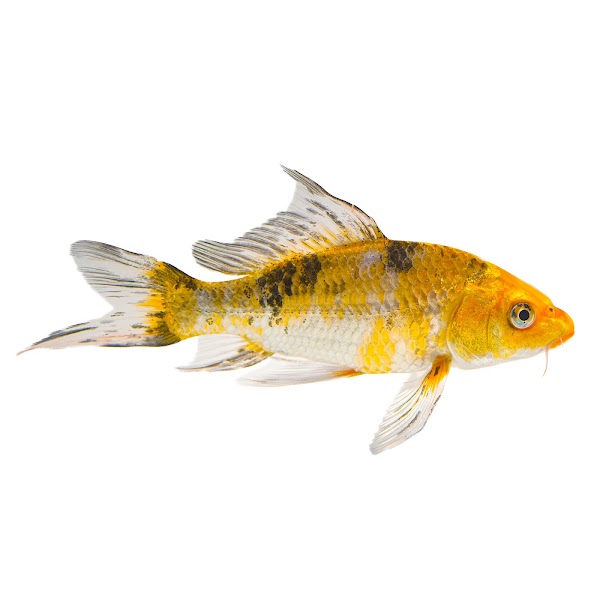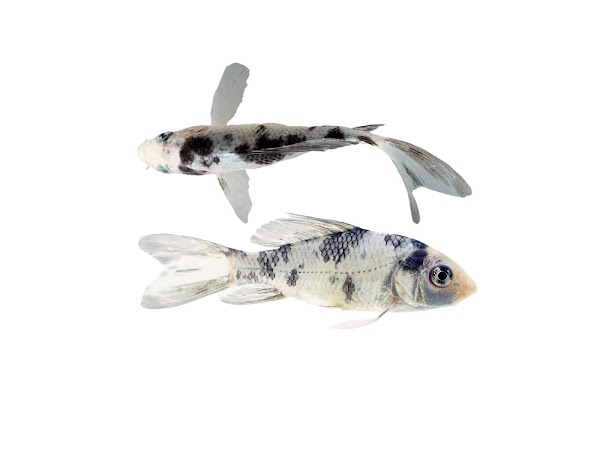The Prettiest Underwater Butterfly

Assorted Butterfly Koi (Cyprinus carpio) are part of the family Cyprinidae known as the minnow or carp family. Butterfly Koi are different from other Koi as they lack a gene that tells their fins to stop growing at a certain point, and thus they develop long flowing fins as they age; this results in a long, elegant fin pattern on older adults. They come in a variety of colors and patterns and could be white, black, red, orange, yellow and any combination of these colors. These fins, colors and size, combined with their excellent hardiness make them one of the most desirable pond fish available.
Koi are a domesticated variety of common carp (Cyprinus carpio) that have been bred for color; carp have been bred in China for color mutations for over a thousand years. More recently, Modern Koi are mostly descended from Japanese lineages that started in the 19th century, and Butterfly Koi have an even younger history. It's widely accepted that the Butterfly Koi share some lineage with a long finned, Indonesian carp that was isolated from some ponds in New York. Breeders crossed these fairly nondescript fish with more colorful koi and over many generations they came to resemble the gorgeous fish we see today. One North Carolina Koi breeder claims to be the originator of this variant (and they may well be), sometime in the late 1970s, but we couldn't definitively prove this as of the writing of this article. Other reports state that Japanese breeders were breeding for this trait well before this timeline. Regardless of the history, as a result of this lineage, some Koi competitions (yes, there is such a thing as Koi competitions) have separate classes for Butterfly Koi, and some competitions do not allow them at all. In North America, where pond owners seem to value their gorgeous shape and movement over their lineage, Butterfly Koi are very popular. This is not the case in much of Asia and Europe.

The native range of Cyprinus carpio covers much of Europe and Asia, and they have since been introduced to every continent except Antarctica. Many species of carp have been brought to new environments for their beauty, some as food fish, and a large number as sport fish. While usually not targeted as such by north Americans, the European Carp is a prized game fish for its incredible toughness and difficulty in catching. Unfortunately, carp released into the wild both intentionally and unintentionally have created many issues with native species and habitats in a huge variety of environments. Carp are generalists, but thrive in slow moving water with some vegetation, an environment well within the capability of the vast majority of pond owners here.
A well cared for Butterfly Koi will live for at least 15 years assuming predators don't find it first. There are reports of fish in Asia and Japan of Koi living past 40 and even some legendary reports suggesting that some have lived well into their 50s. A big, mature old Koi could be three feet long and 25 pounds! Because of this the best home for a Koi is a large garden pond.
Koi ponds should be sheltered to some degree as direct sunlight all day can bring the pond temperatures into dangerous levels in the summer, especially in the hotter parts of the country. Excess sunlight in any pond will also encourage algae growth (see our pond care articles for more.) Any Koi will also need to be sheltered in the winter in the colder parts of North America unless the pond is deep enough to provide shelter from the ice in places where it freezes. Plants can be incorporated but should be kept in some type of planter as carps constant grazing and rooting of the substrate will uproot plants that aren’t protected in some way from them. Powerful filtration and/or aeration are also recommended for keeping Koi.

Koi should be fed a specialized diet specifically designed for them, and only when water temperatures are high enough to support their metabolism, about 50-55 degrees Fahrenheit. Koi will graze in ponds for small invertebrates, algae, plants, and will appreciate offerings of vegetables as well. Floating pellets make a great staple for feeding Koi in ponds as it's easy to see if there is any leftover food when the Koi are done eating.
Well-fed adult Koi will spawn on their own provided a place to lay eggs; with reasonable temperatures, it would be difficult to stop this from happening. Given a big enough pond, some good hiding spots near shore, and (obviously) male and female fish, you should start seeing more Koi in your pond over time. That being said, the eggs and young Koi may be eaten by the Koi themselves and other pond predators, or even sucked down into pond filtration.
Assorted Butterfly Koi are unlike anything else available as a pond fish. They off the bright, beautiful colors and contrast that any other Koi do, to any pond, but in addition add beauty in their graceful swimming and flowing fins. If you're interested in keeping some in your pond, ask your LFS, garden center or pond store retailer for sustainably farmed Koi from Aquatropic today!